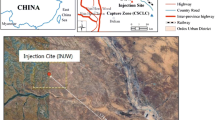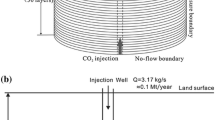Abstract
Storage and disposal of CO2 as the main component of greenhouse gases in saline aquifers require careful measurement of diffusivity for predicting rate of transfer and cumulative amount of trapped gas. Little information is available on diffusion of CO2 in highly concentrated saline aquifers at reservoir conditions. In this study, diffusivity of CO2 was measured into different solutions, including saline aquifer taken from oil field, distilled water and synthetic solutions prepared from four most common ions, Mg2+, Ca2+, K+, Na+. The roles of salvation effect and hydration phenomenon were studied on diffusivity of dissolved CO2. Synthetic solutions were prepared at concentration ranges of 83–200 g/l. Experimental measurements were reported at temperature and pressure ranges of 30–40 °C and 5,880–6,265 kPa, respectively. Results show that both type and concentration of ion affect CO2 diffusivity. Diffusion coefficient was found dependent on effective radius of hydrated ions. Also, CO2 diffusivity increase by increasing strength of bonds between ion and neighbor water molecules. Also, presence of ions in water solution creates hydration competition between solution metal ions and aqua ions from diffusive gas. The Mg2+ cation, which has strongest hydration competition among other ions, has an increasing effect on gas diffusivity into saline aquifer. However, increasing ion concentration in solution decreases diffusivity of CO2 due to growth in fraction of contact ion pairs. Results of this study provide unique measures of CO2 diffusion coefficient in saline aquifer at high pressure and temperature conditions and conceptual information about effect of each common saline formation ion on gas diffusivity.




Similar content being viewed by others
Abbreviations
- C* :
-
Equilibrium concentration of CO2 in brine (kmol/m3)
- D :
-
Diffusion coefficient (m2/s)
- K h :
-
Henry’s law constant (kPa.m3/kg)
- L :
-
Height of gas in diffusion cell (m)
- m d :
-
Diffused gas into the saline aquifer (kg)
- M :
-
Molecular mass of gas (kg/kmol)
- N :
-
Normality
- P :
-
Pressure (kPa)
- R :
-
Universal gas constant
- S :
-
Weight fraction of sodium chloride
- t :
-
Time (s)
- T :
-
Temperature (K or °C)
- Z :
-
Compressibility factor
- E :
-
Equilibrium value
- I :
-
Initial value
References
IPCC (2005) Special report on carbon dioxide capture and storage. In: Metz B, Davidson O, de Coninck HC, Loos M, Meyer LA (eds) Prepared by working group III of the intergovernmental panel on climate change. Cambridge University Press
Huang T (2012) Molecular Dynamics Simulation of Carbon Dioxide in Aqueous Electrolyte Solution. Dissertation submitted in fulfillment of the Requirements for the Degree of Doctor of Philosophy, Swinburn University of Technology
Mortimer RG (2008) Physical chemistry, 3rd edn. Academic Press, Waltham
Du H, Rasaiah JC, Miller JD (2007) Structural and dynamic properties of concentrated alkali halide solutions: a molecular dynamics simulation study. J Phys Chem B 111:209–217
Nakajima H (2011) Dissolution trapping of carbon dioxide in reservoir formation brine—a carbon storage mechanism. Mass Transfer: Advanced Aspects. InTech
Wang JH (1954) Effects of ions on the self-diffusion and structure of water in aqueous electrolytic solutions. Paper presented at the symposium on the solutions of electrolytes, New Haven, June 16
Zeebe RE (2011) On the molecular diffusion coefficients of dissolved CO2, HCO3 −, and CO3 and their dependence on isotopic mass. Geochem Cosmochim Acta 75:2483–2498
Garcia-Ratés M, de Hemptinne JC, Avalos JB, Nieto-Draghi C (2012) Molecular modeling of diffusion coefficient and ionic conductivity of CO2 in aqueous ionic solutions. J Phys Chem B 116:2787–2800
Tae Kwak H, Zhang G, Chen S (2005) The effects of salt type and salinity on formation water viscosity and NMR responses. Paper presented at the international symposium of the society of core analysts, Toronto, Canada, 21–25 August
Unver AA, Himmelblau DM (1964) Diffusion coefficients of CO2, C2H4, C3H6, and C4H8 in water from 6 to 65 °C. J Chem Eng Data 9:428
Thomas WJ, Adams MJ (1965) Measurement of the diffusion coefficient of carbon dioxide and nitrous oxide in water and aqueous solution of glycerol. Trans Faraday Soc 61:668
Tamimi A, Rinker EB, Sandall OC (1994) Diffusion coefficients for hydrogen sulfide, carbon dioxide and nitrous oxide in water over the temperature range 293–368 K. J Chem Eng Data 39:330
Frank MJW, Kuipers AMJ, van Swaaij WPM (1996) Diffusion coefficients and viscosities of CO2+H2O, CO2+CH3OH, NH3+H2O and NH3+CH3OH liquid mixtures. J Chem Eng Data 41:297
Jähne B, Heinz G, Dietrich W (1987) Measurement of the diffusion coefficients of sparingly soluble gases in water. J Geophys Res 92:767
Hirai S, Okazaki K, Yazawa H, Ito H, Tabe Y, Hijikata K (1997) Measurement of CO2 diffusion coefficient and application of LIF in pressurized water. Energy 22:363–367
Tewes F, Boury F (2005) Formation and rheological properties of the supercritical CO2–water pure interface. J Phys Chem B 109:3990
Renner TA (1988) Measurement and correlation of diffusion coefficient for CO2 and rich-gas applications. J Chem Eng Data 3:517–523
Wang LS, Lang ZX, Guo TM (1996) Measurement and correlation of the diffusion coefficients of carbon dioxide in liquid hydrocarbons under elevated pressures. Fluid Phase Equilib 117:364–372
Bahar M, Liu K (2008) Measurement of the Diffusion coefficient of CO2 in formation water under reservoir conditions: implications for CO2 storage. Paper presented at the SPE 116513, SPE Asia pacific oil and gas conference and exhibition, Perth, Australia, 20–22 October
Yang C, Gu Y (2006) Accelerated mass transfer of CO2 in reservoir brine due to density-driven natural convection at high pressures and elevated temperatures. Ind Eng Chem Res 45(8):2430–2436
Moghaddam RN, Rostami B, Pourafshary P, Fallahzadeh Y (2012) Quantification of density-driven natural convection for dissolution mechanism in CO2 sequestration. Transp Porous Media 92:439
Azin R, Mahmoudy M, Jafari Raad SM, Osfouri S (2013) Measurement and modeling of CO2 diffusion coefficient in saline aquifer at reservoir conditions. Cent Eur J Eng 3:585–594
Sheikha H, Pooladi-Darvish M, Mehrotra AK (2005) Development of graphical methods for estimating the diffusivity coefficient of gases in bitumen from pressure-decay data. Energy Fuels 19:2041
Duan Z, Sun R, Zhu C, Chou I (2006) An improved model for the calculation of CO2 solubility in aqueous solutions containing Na+, K+, Ca2+, Mg2+, Cl−, and SO4 2−. Mar Chem 98:131–139
Persson I (2010) Hydrated metal ions in aqueous solution: how regular are their structures? Pure Appl Chem 82(10):1901–1917
Ohtaki H, Tamas R (1993) Structure and dynamics of hydrated ions. Chem Rev 93(3):1157–1204
Richens DT (1997) The chemistry of aqua ions. Wiley, London
Burgess J (1978) Metal ions in solution. Ellis Horwood, Chichester
Köddermann T, Ludwig R, Paschek D (2008) On the validity of Stokes–Einstein and Stokes–Einstein–Debye relations in ionic liquids and Ionic–liquid mixtures. Chem Phys Chem 9(13):1851–1858. doi:10.1002/cphc.200800102
Acknowledgments
The assistance of Messrs Mohammad Mahmoodi and Yasin Gholami in running part of experiments are acknowledged. Also, the authors acknowledge the National Elite Foundation and Persian Gulf University for financial support of this study under contract number 1389-19/1302.
Author information
Authors and Affiliations
Corresponding author
Rights and permissions
About this article
Cite this article
Jafari Raad, S.M., Azin, R. & Osfouri, S. Measurement of CO2 diffusivity in synthetic and saline aquifer solutions at reservoir conditions: the role of ion interactions. Heat Mass Transfer 51, 1587–1595 (2015). https://doi.org/10.1007/s00231-015-1508-4
Received:
Accepted:
Published:
Issue Date:
DOI: https://doi.org/10.1007/s00231-015-1508-4




